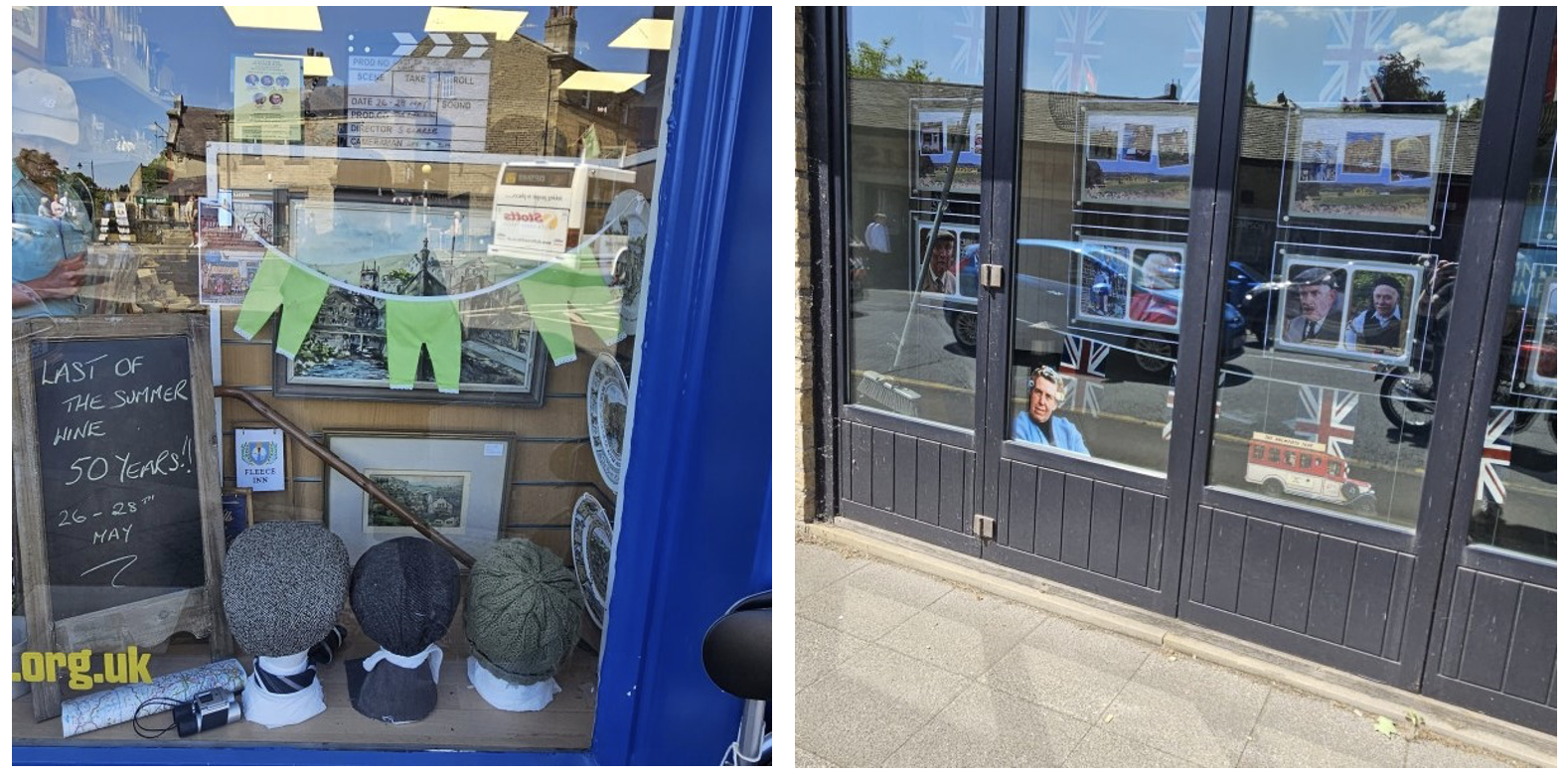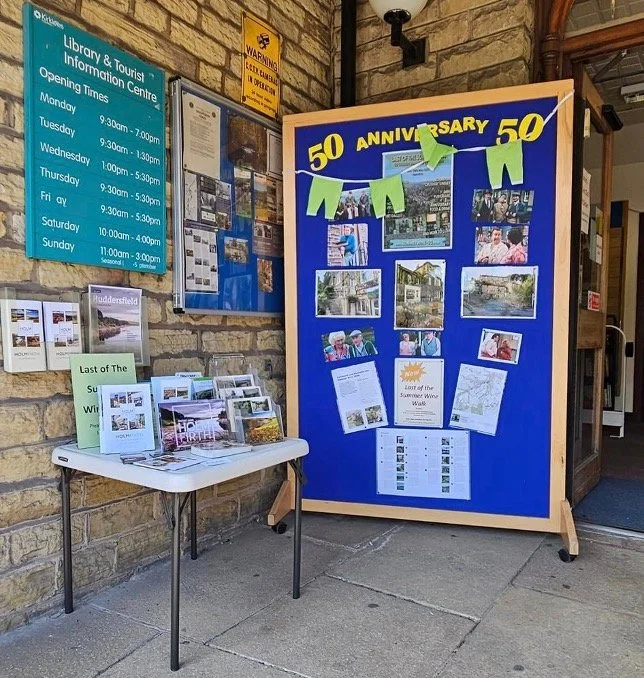Who's Looking After the Cafe Then? Holmfirth and The Longevity of Screen Tourism
/As a kid, one of my Sunday night rituals was sitting in my gran’s living room to watch Last of The Summer Wine (BBC, 1973-2010), a comedy about the escapades of three retired Yorkshire misfits. There was Foggy, the former soldier who often boasted about his exploits during World War Two despite spending it as a sign-writer; Clegg, a redundant lino salesman whose plans for a relaxing retirement get interrupted by the schemes of his friends; and Compo, the lovable rogue who – in between trying to get his neighbour Nora Batty to elope with him – can be found cooking up various ways to stave off boredom. Written by Roy Clarke, the show began in 1973 and ran on the BBC until it ended in 2010, though re-runs are a staple of Freeview channels like Yesterday. The series itself was set and filmed in Holmfirth, a town in West Yorkshire, which also played host to the 50th anniversary celebration weekend in June 2023.
Holmfirth has long embraced Last of the Summer Wine and its tourist legacy. A down-at-heel industrial town facing the loss of its woollen mill when the series first began filming there in the 1970s, it saw increasing numbers of tourists in the show’s first decade - 60,000 a year, according to Andrew Vine. As the show’s popularity increased so did the work opportunities for locals and the income from the rising number of visitors, transforming Holmfirth into a once-again prosperous town and cementing its position at the heart of “Last of the Summer Wine country”. As academics Lynne Hibberd and Zoe Tew-Thompson describe, the show has become “inscribed, embedded and appropriated into the town of Holmfirth and its people”, evidence of which was clear during the 50th anniversary weekend. A window display in one charity shop featured a walking stick, flat cap, and green knitted bobble hat – signature accessories of the main characters – along with a clapperboard announcing the 50th anniversary weekend while a flower shop peppered framed illustrations of key characters and locations among cacti and house plants. A local estate agent dedicated an entire window to the show, and bunting in the shape of frilly bloomers hung everywhere.
Last of the Summer Wine tourism isn’t limited to specific times of the year. The Summer Wine Magic bus tours, which take passengers on a 10-mile journey around the filming locations used in the show, run between 11-4 Wednesday to Saturday and the Wrinkled Stocking Tea Room, part of the building used as the filming location for Nora Batty’s cottage – which is now a self-catering cottage – serves cream teas in a room adorned with photographs, paintings, and memorabilia. In addition to these, the Summer Wine exhibition, located in Compo’s old house, is open year-round. Among the displays of screen-worn clothing and props is a TV showing a documentary about Summer Wine and its impact on the town, along with a plaque proclaiming that the show was Queen Elizabeth II’s favourite and stacks of condolence books filled with memories from fans following the death of Bill Owen (who played Compo) in 1999. I sat in the exhibition for a while, watching the documentary, and several families passed through while I was there. One wanted to sign a book of condolence – testament to the generational fandom of the show as adults who watched it as kids share the same ritual with their own children – while another told me how much they missed having something like Last of The Summer Wine on TV now.
Perhaps one of the most famous locations in Holmfirth, though, is Sid’s Café. Owned by Laura Booth, who was instrumental in organising the 50th anniversary celebration, the café is also an accessible filming location. And the transformation of the café perhaps epitomises the effect the show and its fans had on Holmfirth. When the series was filmed, the building was used as storage for the ironmonger’s next door, the exterior decorated for filming by the BBC. As fans began visiting the town, the building was bought and turned into a working café, which itself was then used as a filming location (as in the 1985 episode whose title has been used for this blog post). Although filming ended in 2010, when I arrived in Holmfirth, Sid’s café was full of fans who had arrived for the anniversary weekend. One couple, who travelled from Kentucky, were among the scores of viewers who had visited Holmfirth from overseas. As Laura Booth points out, visitors come “from all over the world - America, Australia, Corsica, Sweden" and people from a range of different countries were at the anniversary weekend.
The weekend itself was co-organised by Bob Fischer and Andrew T. Smith, who set themselves the task of rewatching and blogging about Last of the Summer Wine following the airing of its final episode. Calling themselves the Summer Winos, they have since performed at the Edinburgh Fringe as well as at the celebration weekend. Speaking to Bob and Andrew, they highlighted the symbiotic relationship between the show and the town, pointing out that many of the prime filming locations are now businesses owned by locals: “the town itself, or the all the businesses of the town, have very much embraced the series and used the series as a focal point to bring people into the town” and one way of bringing people into the town while recognising and celebrating the show’s fiftieth anniversary was to hold an anniversary weekend.
Businesses and locals involved in the weekend’s events included: The Nook Brewhouse, which had also created a special anniversary ale, ‘Fill your boots with Blonde’; The Civic, which was the venue for ticketed events including an audience with Jonathan Linsley (who played Crusher in the show) and a charity screening of the feature-length episode “Getting Sam Home”; Imagine Toy Shop, which was a stop on the “Captain Clutterbuck’s Treasure Hunt” and played host to a giant matchbox similar to the one Compo carried around in the show; and local Greengrocer Andrew Bray, who gave a talk on his friendship with Bill Owen and other members of the cast and crew. In addition, Holmfirth Library and Walkers Are Welcome Group produced a Summer Wine walk, details of which were available from the library. Holmfirth embraced Last of The Summer Wine but did so without any involvement, funding, or partnerships with the BBC (although the broadcaster did give permission for the gala screening of “Getting Sam Home” to be shown, requesting all proceeds go to Children in Need). The ‘active presence’ of Last of The Summer Wine in Holmfirth is therefore established by locals, businesses and the fans who travel there to see the sights they’re familiar with from the screen. Although The Last of the Summer Wine ended thirteen years ago, Holmfirth is still a draw for fans, and the fiftieth anniversary weekend demonstrates how businesses, local council, and tourism organisations can work together to take advantage of screen tourism.
This research was funded by the University of York.
Biography
Bethan Jones is a Research Fellow at the University of South Wales. She has written extensively about anti-fandom, media tourism and participatory cultures, and is co-editor of Crowdfunding the Future: Media Industries, Ethics, and Digital Society (Peter Lang) and the forthcoming Participatory Culture Wars: Controversy, Conflict, and Complicity in Fandom (under contract with University of Iowa Press). Bethan is on the board of the Fan Studies Network, co-chair of the SCMS Fan and Audience Studies Scholarly Interest Group co-editor of Popular Communication.



